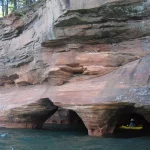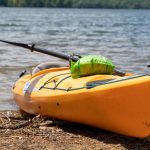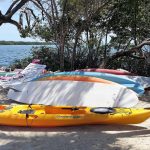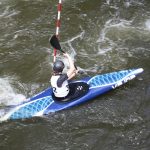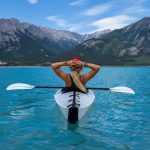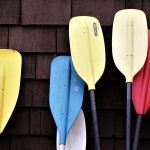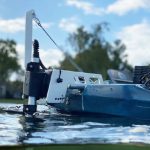Some of the most exciting paddling adventures can be found in Wisconsin. We’ve collected a few of the best spots to go kayaking in the Badger State.
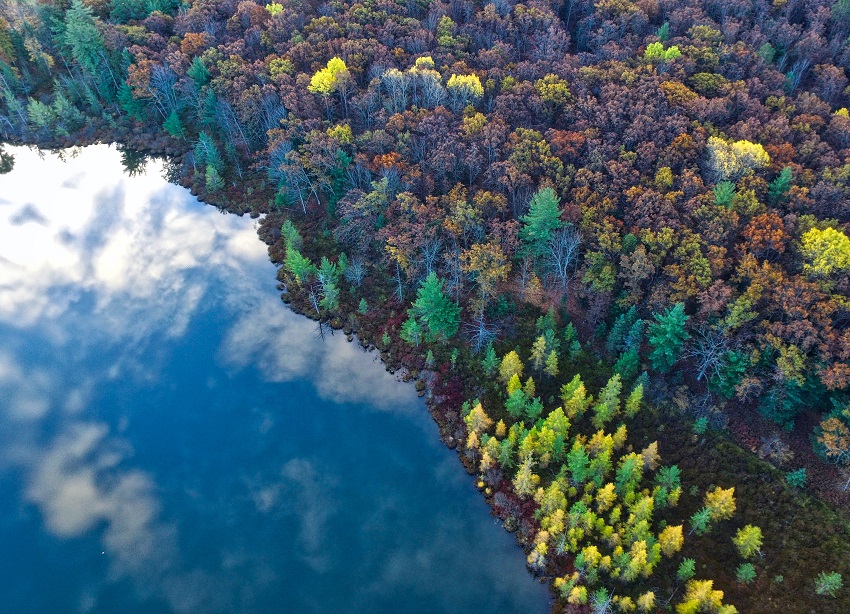
Welcome to Michigan, home to some of the greatest kayaking spots in the entire United States!
The state’s name is an Ojibwe word meaning “large water”, and that’s the perfect way to describe the Great Lakes State. With access to four of the Great Lakes, it’s truly a spectacular place to indulge in your favorite water sports and explore all the glorious paddling destinations on offer.
Below, we’ve compiled a list of the best places for kayaking in Michigan, along with information on how to find kayaking tours in Michigan, smart tips for Michigan kayakers, a breakdown of the most important Michigan kayaking laws, and, of course, a few of the most commonly asked questions about kayaking in Michigan.
Read it all, and I guarantee it will make your next kayaking trip to Michigan a lot safer and more enjoyable!
15 Best Places to Go Kayaking in Michigan
1. Lake Michigan
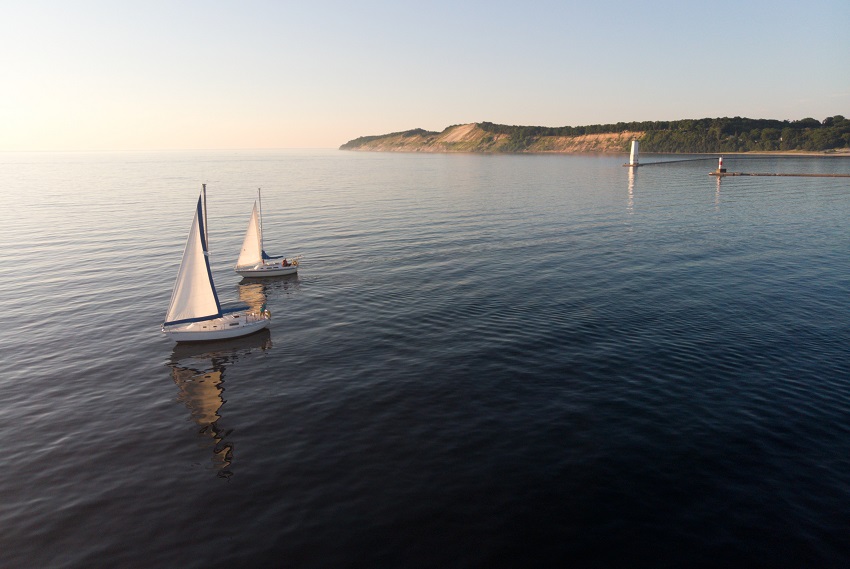
Because of course this is the coolest place to go kayaking in Michigan! This Great Lake offers plenty of paddling adventures for beginners; all you have to do is stay close to the shore, and you can explore the campgrounds, hidden creeks and inlets, and secluded spots only accessible via the water. Or, if you want to tackle a longer, more adventurous trip, you can try the 16-hour lake crossing trip.
Be aware that the lake can get windy later in the evening and into the night, so make sure to plan your trip so you complete the crossing before it gets fully dark. And bring plenty of food and water to stay hydrated and nourished on the long, hard paddle.
2. Au Sable River
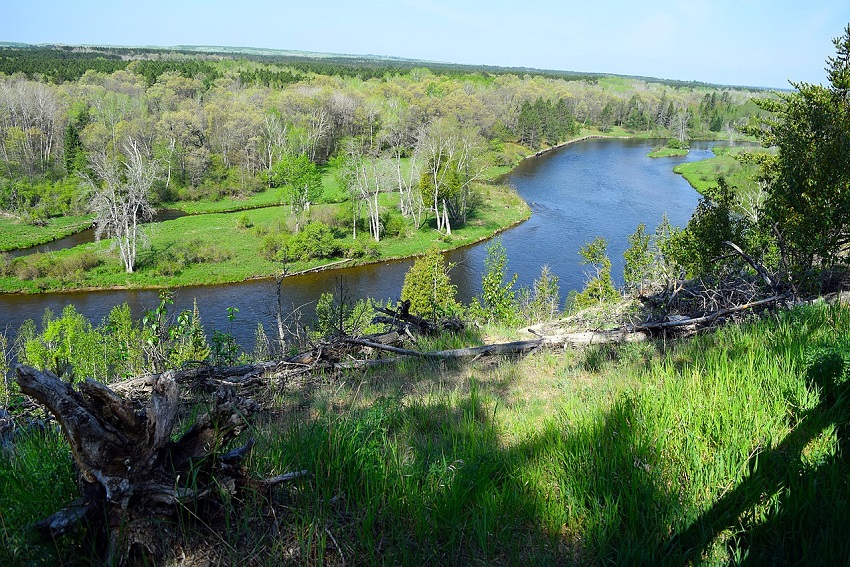
The Au Sable River spans more than 100 miles, running through Michigan’s northern lower peninsula and giving you access to some truly picturesque locations on its way to joining Lake Huron. You can plan to paddle the entire length of the river, turning it into a multi-day trip with stops along the many campsites bordering the river. Or, you can just spend a day paddling upstream or downstream and enjoying the river’s calm flow.
Adventure paddlers, be aware that there are stretches of Class II rapids you can tackle, though you’ll have to portage around a few dams. Anglers will also find there’s plenty to keep them busy all day long, casting for delicious river trout.
3. Crystal River
Want something a bit shorter but more adventure-packed? Try out the Crystal River, an amazing place for beginner paddlers to get their feet wet and have a day of fun. You’ll spend 2-3 hours paddling downstream, enjoying the gorgeous, crystal clear water and scenic lakeshore views. The tide is just fast enough that it will get you where you want to go, but it’s still easy paddling suited for newbies.
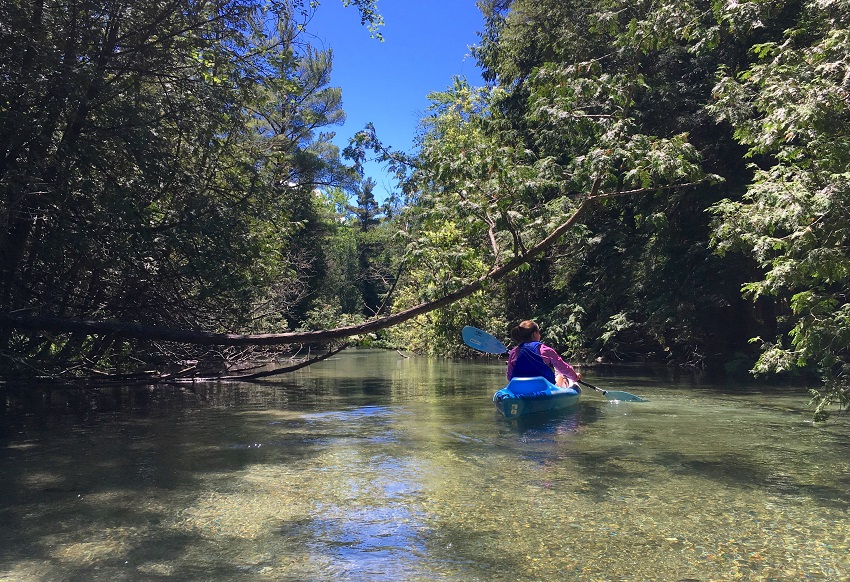
But brace yourself, because it’s here you’ll find “Shooting the Tube”, a culvert that will whoosh you across the lake at brilliant speeds. And once you’re done, you can paddle toward the end of the river, which is downtown Glen Arbor. There, you can spend the evening walking around one of Michigan’s finest beach towns and enjoy a lovely meal with your paddling companions.
4. Detroit’s Urban Canals
You don’t have to head far out into nature to enjoy paddling; just find the many urban canals available in Detroit, and you’ll have a truly memorable kayaking experience. These waterways connect the city of Detroit to the Detroit River, but they cut through the heart of the city on their journey downstream. They offer breathtaking views of Motor City from a brand new perspective, and are close enough to your hotel that you can be “there and back again” with plenty of time to spare.
(Note: It’s recommended that you sign up for a local tour rather than tackling Detroit’s Urban Canals on your own. There are many hidden dangers that you may not know about, and could lead to some serious trouble if you head the wrong way.)
5. Manistee River
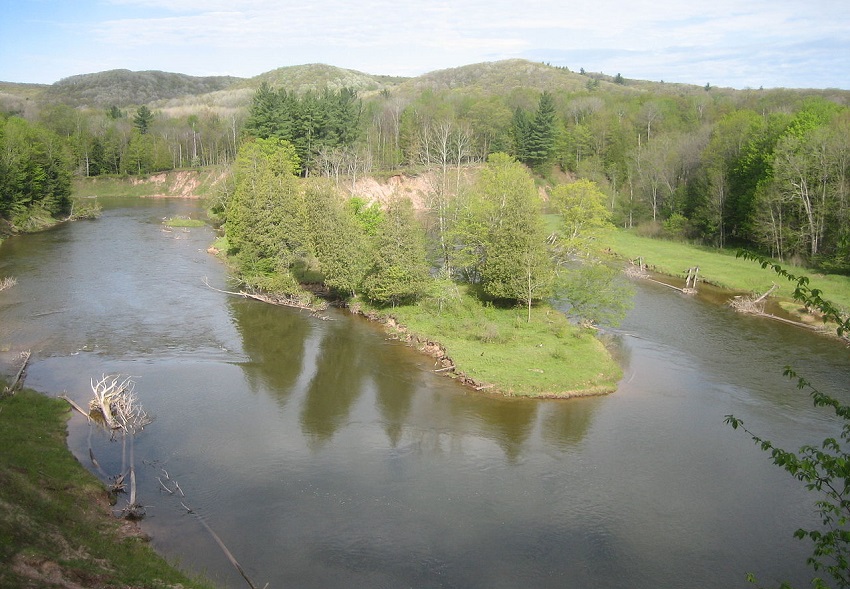
If the Au Sable River seems a bit too much of a challenge to tackle on your first kayaking trip to Michigan, given the Manistee River a try. It’s located on the same northern lower peninsula—in fact, it actually runs parallel to the Au Sable for 12 miles—but it’s a much calmer, slower-flowing river with a lazy current that will let you paddle at your own pace.
Along the river, you’ll find countless places to camp, spectacular scenery, and even views of the local wildlife. There are a few dangerous sections (including dam crossings that can be challenging), so it’s a good idea to consider making it a day trip with just a few hours of relaxing on the water.
6. Turnip Rock
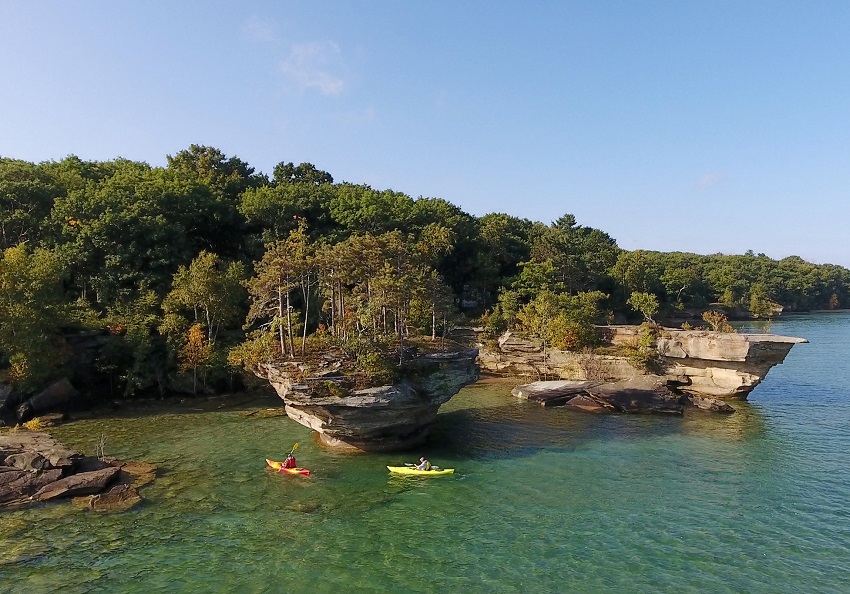
If you’re anywhere near Lake Huron, you can’t pass up the opportunity to visit one of its most unique—and bizarre—local sights! Turnip Rock is a rock formation shaped like a turnip, and the top-heavy formation has defied gravity for thousands of years, a marvel of natural creation.
To reach the rock, you’ll get to paddle for 7 miles, but once there, you’ll find plenty of places to stop to take pictures or get out of your kayak and touch the fascinating rock yourself. Fair warning: the land around Turnip Rock is private property, so you’ll have to stay in the water.
7. Pictured Rocks
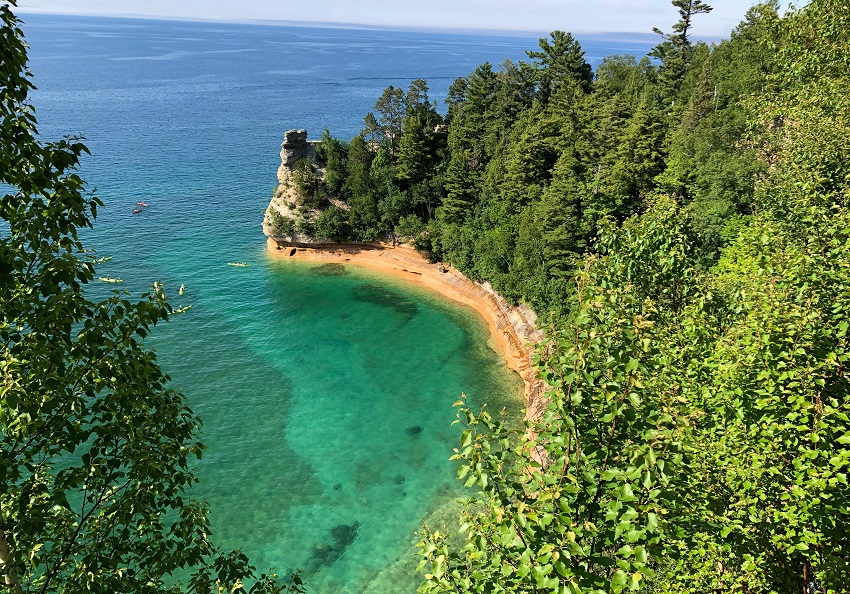
If you’re an experienced paddler looking for a more challenging adventure, the paddle to Pictured Rocks is just what you want. On the surface, it may look easy—the stretch of Lake Superior in Michigan’s Upper Peninsula appears much like any other—but the terrain can be rough and the conditions unpredictable. You’ll have to have a good handle on your paddling skills and kayak to stay safe near these rocks.
But if you’re up for the challenge, you’ll find it’s truly one of the most breathtaking spots on Lake Superior. The multi-colored, multi-layered rocks appear like something out of a fiction novel, and you’ll enjoy the gorgeous waters of Lake Superior on your adventure trip.
8. Huron River
Anyone who wants to plan a multi-day paddling trip should definitely give Lake Huron a closer look. The river stretches for 130 miles, 104 of which are amazing for kayaking. On the river, you’ll find plenty of calm, easy paddling sections (near the river’s mouth) as well as Class II rapids for adventurers wanting a real challenge.
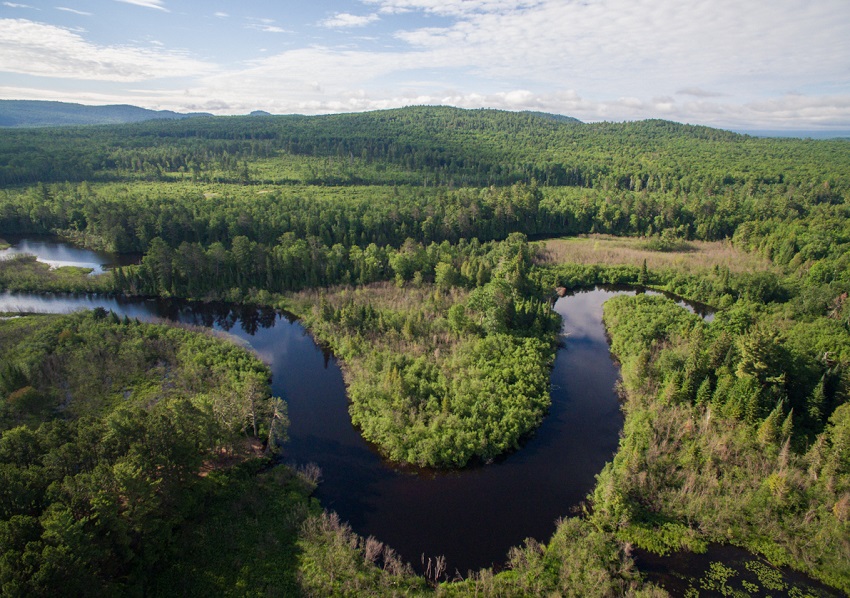
Not only are there four campgrounds where you can spend the night, but there are nearly forty access points along the length of the river where you can put in/pull out. The Huron River is a truly unforgettable adventure suitable for everyone from beginners to experts.
9. The Grand River
The Grand River truly lives up to its name, offering unique views and scenery found nowhere else in Michigan. In fact, entire stretches of the river have been utterly untouched by human hands, with no access to civilization whatsoever, so everything is pristine and natural. Here, you’ll find wildlife galore, birds aplenty, and even fish to serve as your dinner.
The river runs a whopping 260 miles, and it’s the longest in Michigan. You’ll end up in Lake Michigan at the end of the journey and enjoy every mile along the way. Nature lovers who want to get away from the crowds and noisy cities will definitely want to plan a trip down this breathtaking river.
10. Two-Hearted River
Just the name alone sounds fascinating, doesn’t it? The river meanders toward Lake Superior, and at the spots where the lake and river connect, the water blends in a truly fascinating pattern—some have compared it to “a mixed drink on ice”. Only once you see it will you understand how absolutely stunning this confluence of different waters can be.
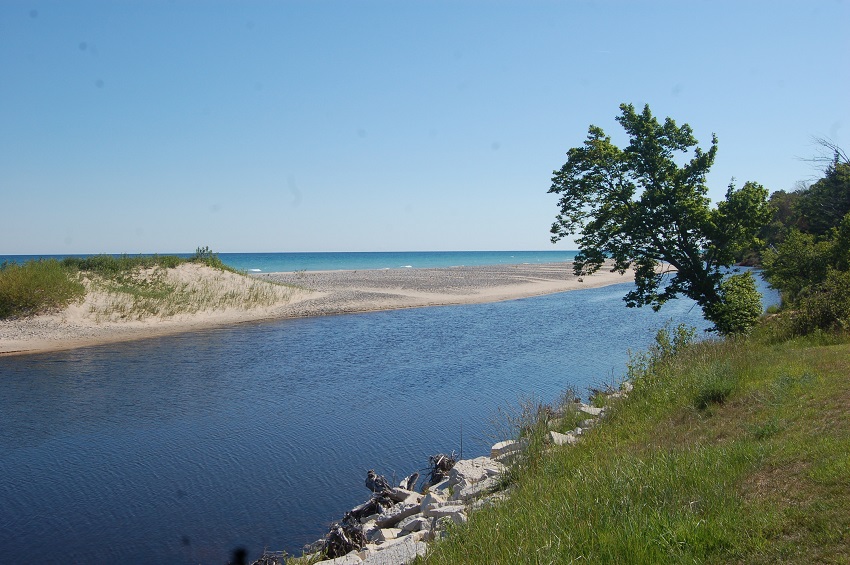
Take note: there are sections where you’ll have to portage your kayak around obstacles or past log jams. The river can be a bit unpredictable, even dangerous, so it’s a good idea to paddle it with an experienced guide or as part of a tour. Give yourself the entire day to make the trip—it will be well worth enjoying the ride!
11. Ann Arbor
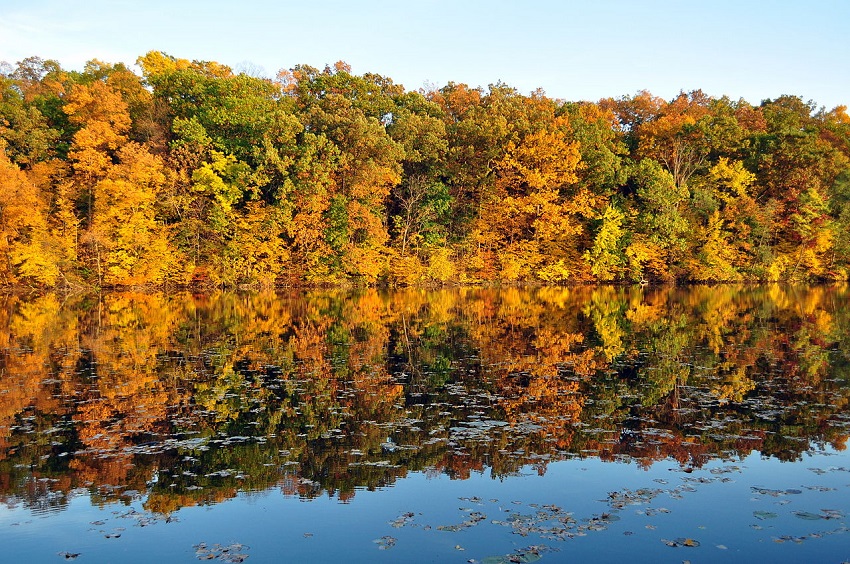
Yes, that Ann Arbor! Few places in Michigan are as popular as the city that is home to museums, gorgeous buildings, culinary delights, and technological marvels. Whether you’re in town for work or pleasure, it’s worth taking a few hours to paddle around the downtown area.
The stretch of the Huron River that runs through Ann Arbor is calm and easy for beginners, and you’ll find it’s short enough to make a great day trip. On the river, you’ll get to enjoy plenty of wide-open green spaces, the clear blue sky above, historic bridges, famous landmarks, and small towns that have stood for hundreds of years. It’s a chance to see one of Michigan’s most famous cities from a new and unique perspective!
12. Elk Rapids
Head to the small town of Elk Rapids in the Lower Peninsula, and you’ll find a bounty of paddling options. Rivers, lakes, streams, and, of course, rapids (largely Class II), all great for a day or three spent out on the water.
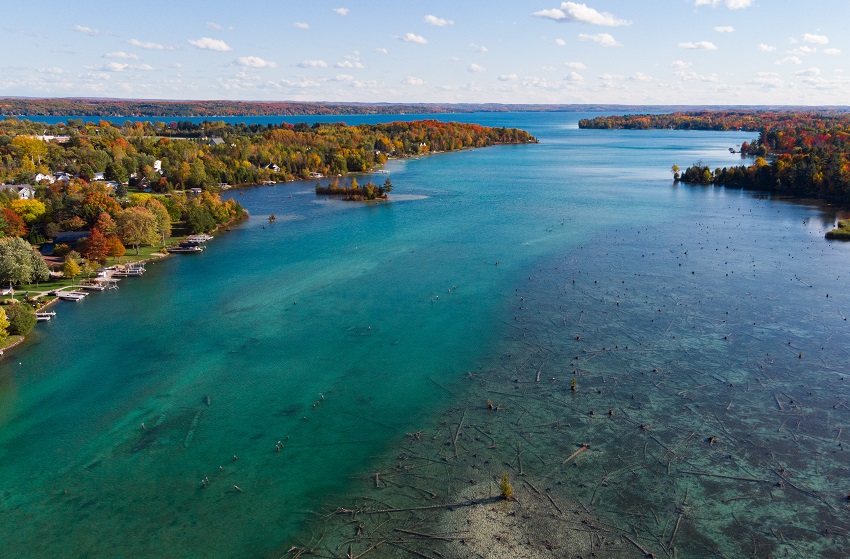
The nearby Elk Lake is also the starting point for the “Chain of Lakes”, a series of twelve lakes and four rivers that are all interconnected and make for a spectacular paddling adventure for both beginner and intermediate kayakers.
13. Lake Dubonnet
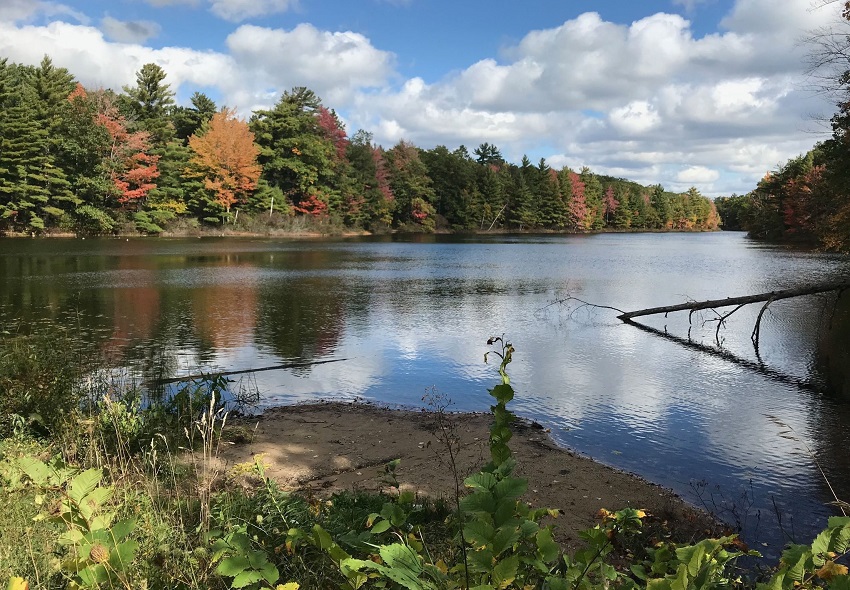
Anglers flock to Lake Dubonnet to enjoy long days out on the water, but you’ll find there are few paddleboarders or kayaks. This means that you’ll have the lake largely to yourself and the fishing boats, perfect for enjoying a calm day of paddling (minus the occasional wake from a passing motorboat).
On the lake, you’ll be treated to views of sprawling forests, wildflowers and water lilies, and animals along the shore and swimming in the river. Autumn is one of the best times of year to paddle this lake—it’s worth braving the chill to see the riot of colors surrounding you as the forest shifts to its fall foliage.
14. Tippy Dam Pond
It may be called a “pond”, but this 1600-acre body of water is far from the puddle you might be imagining. Tippy Dam Pond is the name given to the backwaters surrounding Tippy Dam, and it stretches for a full five miles, surrounded on all sides by pristine, unspoiled nature. Here, you can enjoy a calm day on a mostly flatwater lake, with only the occasional gusts to stir up the water. Beginners will definitely find this a great place to dip their paddles in for the first time.
If you’re very lucky (and very quiet), you may be able to see wildlife in its natural habitat coming surprisingly close to you—whether you’re in your boat or on the shore.
15. Lake St. Clair
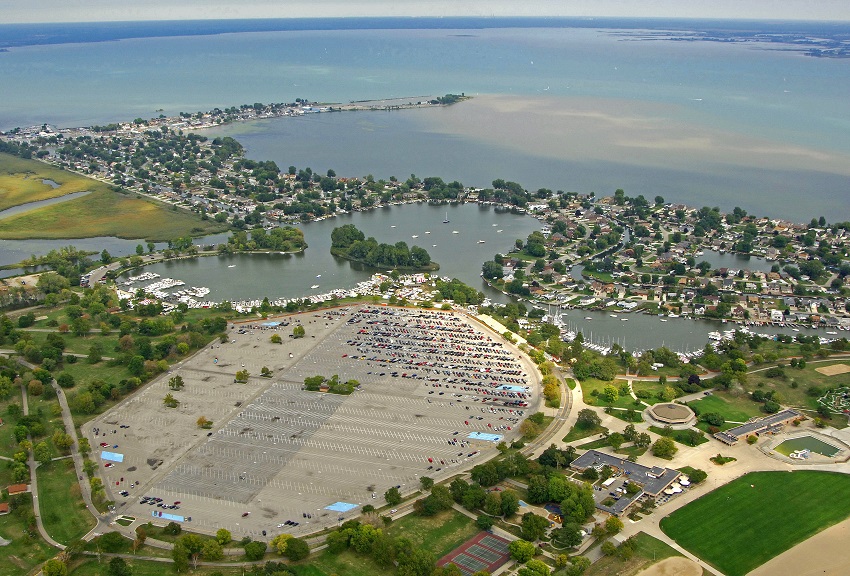
Lake St. Clair is home to the largest freshwater delta in the world, and is the perfect place for you to experience first-hand what happens when a narrow river spills out into a wide lake. There are also hundreds of tiny creeks and canals where you can test your paddling skills or explore away from the lake. Or, at the end of a long day, drop anchor and head to the shore for a night of camping.
On the lake, you can find four different paddling trips (guided and solo), accessible through any of the 16 launch sites. It’s not the largest lake in Michigan, but it’s definitely one of the most memorable, with gorgeous waters and access to absolutely wonderful spots to spend the day with your family and friends.
Kayaking Tours in Michigan
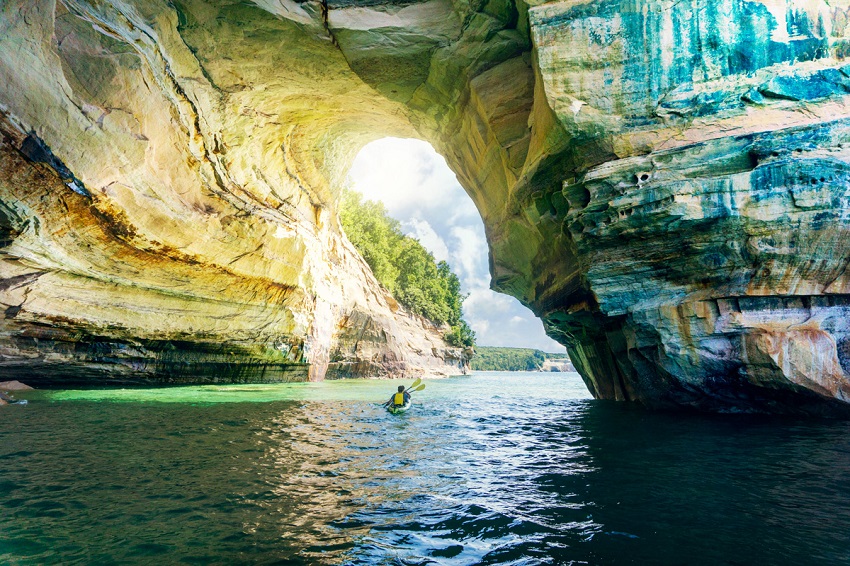
Aren’t the destinations above truly amazing? Some pretty epic places to put in your kayak and explore some of the most wonderful, riveting, picturesque locations in the Midwest!
As you saw, many of the kayaking spots I shared above were accompanied by warnings of potential hazards and dangers—log jams, dams, unpredictable currents, and more. Every trip you take into unknown spots, no matter how calm, do carry some risks.
If you’re an experienced paddler, you probably feel confident enough to tackle the challenges on your own—after doing extensive research, of course.
Newbies and intermediate paddlers, however, may be better-served connecting with one of the local kayaking tours in Michigan. With these tours, you’ve got A) access to gear (if you can’t bring your own), and B) the advice and guidance of someone who spends their days paddling these waters.
With an experienced guide, you’ll avoid the worst of the obstacles, learn a few tricks and tips for better paddling, and even learn a few of the secrets known only to locals. People who live near/at each of these spots know how to spot wildlife, ride the river currents just right, get the best picture of scenic locations, and, of course, navigate safely there and back again.
It’s not just safer to consider a kayaking tour; you may also get a lot more out of the time spent out on the water!
Here are a few of the kayaking tours in Michigan you may want to consider:
- Paddling Michigan (tours of Pictured Rocks)
- Keweenaw Adventure Company (guided trips to Porter’s Island, Agate Harbor, and other Lake Superior destinations)
- Port Austin Kayak (tours to Turnip Rock, the remains of the Dorcas Pendell, and Harbor Beach)
- The River Outfitters (tour of Traverse City, including local breweries)
- Superior Kayaking (tours of Presque Isle)
- Crystal River Outfitters (tours of Crystal River, including in glass-bottomed kayaks)
- Carlisle Canoe Livery (tours of the Au Sable River)
- Great Turtle Kayak Tours (tours of Mackinac Island and Lake Huron)
More great resources to check out for kayaking tours in Michigan include:
- Trip Advisor – Just input “kayaking trips” and set the website to Michigan, and you’ll find access to nearly 100 different kayak/canoe rental and tour services around the state.
- Google Maps – Search the entire state or narrow your search down to one city/town/destination. Google Maps will show you where to go, how to get there, and provide the contact information for the tour service.
- Yelp – Yelp not only provides information on various tours and rental companies, but real-life user reviews and feedback from paddlers who have enjoyed the tours (or not) in the past. A great resource to check out to find more personal information on a tour.
Tips for Safely Kayaking in Michigan
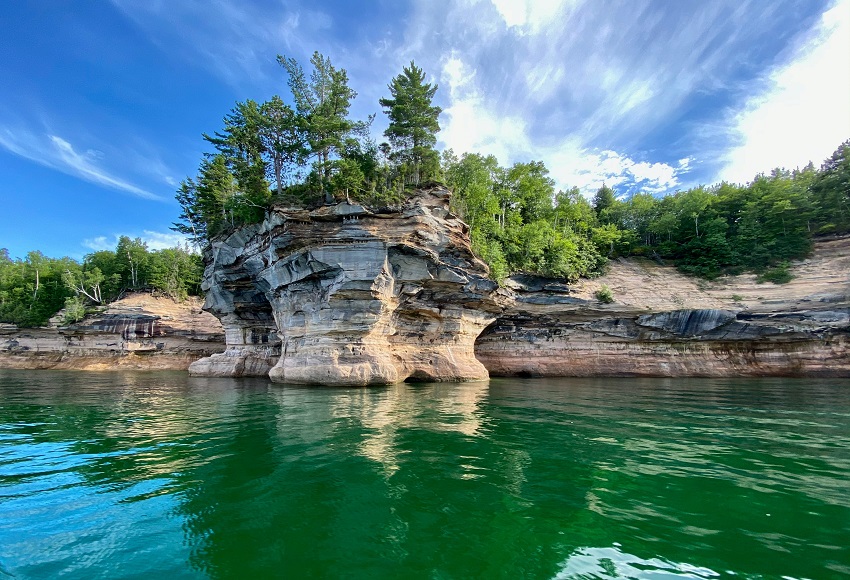
There are so many amazing places to kayak in Michigan, but some of them present greater dangers than you might realize. Even experienced and expert-level paddlers need to take the right precautions in order to safely enjoy their Michigan kayaking trips.
Here are a few tips to ensure you make the most of your time paddling in Michigan without putting yourself at risk:
Never Go Alone
Whether you’re crossing Lake Michigan or paddling down a river, it’s always best to travel in at least groups of two (more is better!). Consider signing up with a tour or bringing along a group. Multiple people traveling together means greater safety.
Know Your Surroundings
Before you head out on any kayaking trip, take some time to familiarize yourself with the challenges, terrains, and wildlife unique to your destination. Take the time to research the rivers, lakes, streams, and waterways you’re going to be paddling in order to learn about and prepare for any possible dangers and hazards. Knowledge is more than just power; it’s crucial to your safety! Also, you might use our interactive map of places to go paddling while planning your next kayaking trip.
Paddle to Your Skill Level
If you’re brand new to kayaking, it’s a good idea to stick with beginner-friendly waterways and lakes. You can tackle rapids and challenge yourself to make the 16-hour crossing of Lake Michigan once you get a bit more experience. Start off with easy paddling trips until you get some skill under your belt, then slowly take on more and more challenges as your confidence and abilities grow.
Bring the Right Kayak
Recreational kayaks will be great for paddling rivers and calm lakes, but you’ll need a sea kayak for larger bodies of water (like the Great Lakes). If you’re going to tackle whitewater rapids, you’ll need a whitewater kayak built specifically for speed and agility.
When planning your trip, make sure to bring the right kayak for the type of water you’ll be paddling. Or consider renting if the kayak you’re bringing isn’t suited to your destination.
Know Your Gear and Swimming Skills
Make sure that you’re familiar with your paddle, PFD, and kayak before you head out on any adventure. If you’re renting, it’s worth taking a few minutes to paddle around and get a feel for the kayak’s stability, tracking and handling, and maneuverability. Adjust your paddle and loosen/tighten your PFD as needed.
Above all, make sure that you know how to safely exit the kayak in case you capsize, as well as how to self-rescue and re-enter. Your PFD will keep your head above water, but you should still know how to tread water and swim yourself back to safety.
Be Prepared to Portage
When traveling down the many rivers and waterways that run through Michigan, it’s likely that you’ll encounter hazards: dams, logjams, sweepers, strainers, etc. Be prepared to make landfall and portage (carry) your kayak around obstacles. It’s better to spend the extra time (an hour or two) and effort rather than putting yourself, your kayak, and your fellow paddlers at risk!
Watch the Weather
The weather on the Great Lakes can be unpredictable. It’s not uncommon for a calm day to suddenly become windy and the flat water to grow choppy, or for a stormcloud to unexpectedly roll in and turn the warm day cold and rainy.
Before heading out on your paddling trip, it’s always best to check the weather forecasts for the time (hours or days) you’ll be out on the water. If there is any chance of a storm, high winds, or heavy rains, be prepared to cancel the trip or turn back. Storm and rains can make even normally safe rivers dangerous and put you at serious risk when paddling around even the smaller Michigan lakes.
Watch for Other Boats
Motorized vessels like fishing boats and speedboats are a potential danger to be aware of on all lakes. Give them a wide berth, and make sure you’re highly visible at all times—especially after dark!
And when you’re on the Great Lakes, be aware that you’re kayaking on one of the largest shipping lanes in the United States. The St. Lawrence Seaway connects the Great Lakes to the Atlantic Ocean, which means enormous freight ships will share the waterways with you. They may not be able to spot you, and though they’re large, they can move very quickly, leading to a collision (which you’re definitely going to get the worst of). They also generate a large wake that can increase the likelihood of capsize.
If you’re attempting to cross any of the Great Lakes, it’s a good idea to pack GPS devices to help you stay on course. The Great Lakes are large enough that you will lose sight of the shore—it’ll feel like you’re in the middle of the ocean! With GPS and navigational devices, you can always know where you are, where you’re going, and how far you have left to paddle before you reach your destination.
Be Aware of International Borders
The northern sides of Lake Huron, Lake Erie, and Lake Superior are all on the Canadian side of the border. While you are legally allowed to paddle Canadian waters, you cannot make landfall without immediately reporting your presence to Canadian Customs/Immigration and presenting your documents. If you make landfall on Canadian soil, you’ll also need to report yourself to U.S. Customs upon your return.
Michigan Kayaking Laws

Kayaks are non-motor powered vessels
As an “unpowered” or “human-powered” vessel, there is no need for you to register your kayak before bringing it to Michigan to kayak. You can operate it safely on any waterway or lake without the need for a permit.
That being said, if your kayak has a trolling motor (for fishing), you will need to A) remove the motor before bringing it into Michigan, or B) register the kayak and obtain a permit. The addition of the trolling motor makes it a motorized vessel.
There is no minimum age for operating a kayak
The only age restrictions are for motorized vehicles: anyone under 12 years old can only operate a motor with less than 6 hp. Kids are able to use kayaks, canoes, and paddleboards at any age with no restrictions.
RELATED: 8 Best Kayaks for Kids
Kayakers must have one lifejacket on board per person
The PFD must be U.S. Coast Guard-approved, and must be either Type I, Type II, or Type III. The PFD must also be sized correctly to fit the paddler and within easy reach/access.
In Michigan, children under 6 are required to wear the PFD while on board the kayak.
Kayakers must carry lights at “low visibility times”
This refers to night time, dawn, dusk, or in times of heavy fog or rain. The light must be fully visible from all angles. If not mounted/affixed permanently to the kayak, it must be deployable within “sufficient time” to prevent accident or collision. Check our article describing the best kayak lights for night fishing and paddling.
White lights are required, but green and red lights typically utilized by larger boats are not (though they are a good idea if you plan to be out on the Great Lakes at night).
Kayakers must carry a sound-producing device
Typically, this will be a whistle, though many kayakers opt to have an air horn as well.
Kayaks must carry visual distress signals (VDS)
When on the Great Lakes, paddlers must carry visual distress signals between sunset and sunrise. Kayakers need to have either electric distress lights or a minimum of three flares.
Kayakers absolutely can get a BWI/BWVI
“Boating While Intoxicated” is the kayaker’s equivalent of a DUI. You are required to avoid alcohol, drugs, or any other sort of influence even though your kayak isn’t motorized.
You can get a BUI if your breath or blood alcohol level is above 0.08% (typically after 1-2 drinks, depending on your size). You can get a BWVI (boating while visually impaired) if you are visibly under the influence of drugs or alcohol while boating.
The penalties for a BWI are:
- $100 to $500 fine, plus 45 days of community service and/or up to 93 days in jail on the first offense
- $200 to $1000 fine on the second offense, plus #1) 10 to 90 days of community service and up to 1 year in jail, or #2) 48 hours to 1 year in jail and 90 days of community service. The privilege to operate a motorboat will be suspended for at least 2 years.
- $500 to $5,000 fine plus 1 to 5 years in jail on the third offense. Additionally, the court may decide to suspend the offender’s motorboat privileges completely and indefinitely, or only for a minimum of 2 years.
- If the BWI results in injury to someone else, the fine is $1,000 to $5,000 and the offender may spend up to 5 years in jail.
Kayaking in Michigan FAQs
What type of kayak is best for Lake Michigan?
Because of its size, Lake Michigan may feel more like paddling on the open ocean than paddling on a calm, flatwater lake. You will encounter crosswinds and strong currents, and you’ve got a long way to paddle to reach the other side of the lake. You’ll be better off with a long, slim, speedy sea kayak with its enclosed cockpit and low profile.
Can you kayak across Lake Michigan?
You absolutely can! In fact, it’s such a popular activity that it earned #1 spot on our list of the “best places to go kayaking in Michigan”.
Be warned: it’s a 16-hour trip (each way!) and the winds can be dangerous when they pick up at night. It’s not a paddle for beginners, but more experienced kayakers will find it’s a truly breathtaking and exhilarating journey.
Can you paddle board on Lake Michigan?
Paddleboarding on Lake Michigan is one of the most popular summer activities for both locals and visitors alike. Typically, SUPs are best off closer to shore, on the warmer, sunnier days with less wind to risk carrying you out into the lake or stirring up the water to a frothy chop.
However, people have actually paddleboarded across Lake Michigan! The record is currently around 18 hours.
Can I kayak on any river in Michigan?
Absolutely! Because kayaks are non-motorized watercraft, they are legally allowed to operate on rivers and waterways where motorized boats are not permitted. As long as you’re aware of the dangers you may find on the river, you’re free to paddle to your heart’s content!

